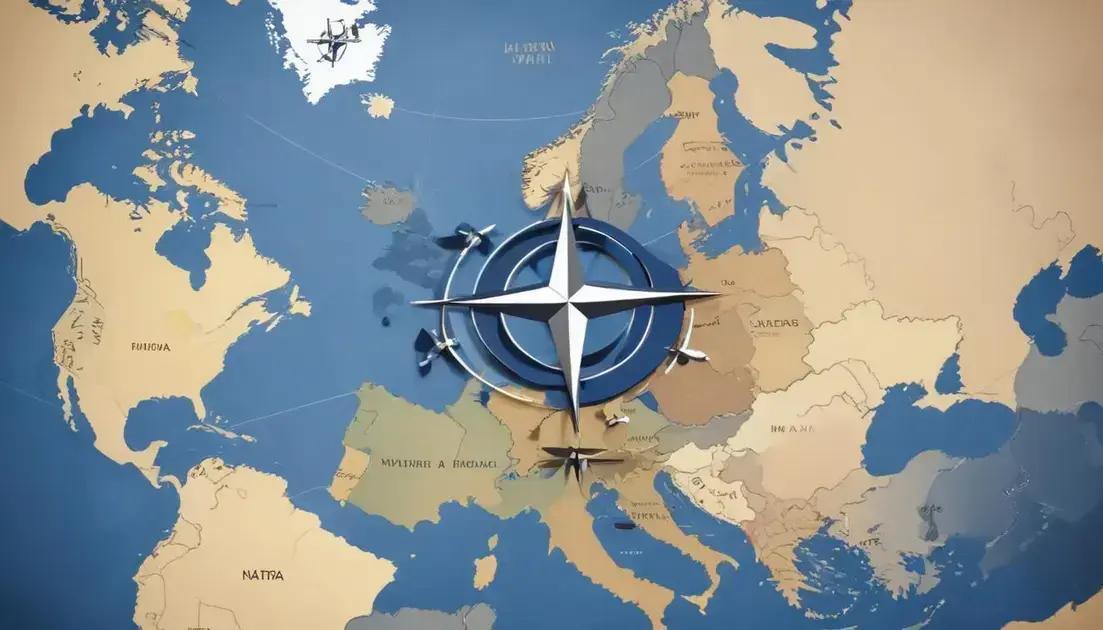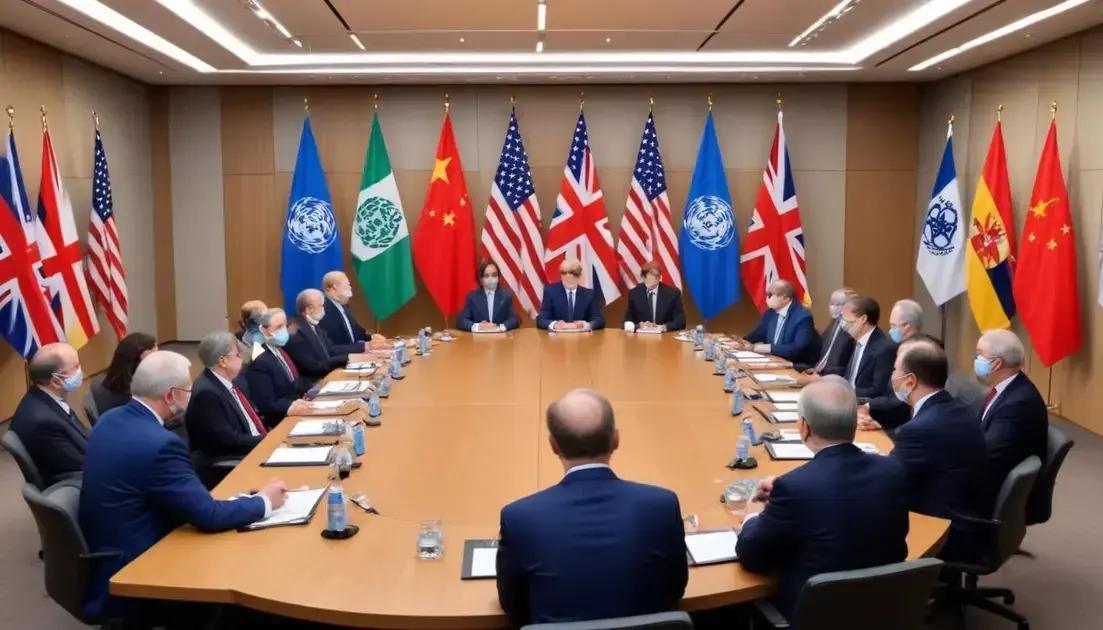
NATO’s new purpose in a divided world
NATO plays a vital role in global security by adapting its strategies to modern threats such as terrorism and cyber attacks. The alliance emphasizes the importance of diplomacy and cooperation among member nations to address conflicts effectively. Public perception and media influence greatly affect support for NATO, making transparent communication essential. As NATO evolves, its commitment to peace and security remains strong, showcasing the significance of international partnerships in ensuring stability.
NATO has evolved significantly since its inception, but is it still relevant in today’s complex global landscape? Join us as we delve into its current purpose and challenges.
The Historical Context of NATO
NATO, or the North Atlantic Treaty Organization, was formed in 1949. At that time, the world was recovering from World War II. Many countries faced threats from the spread of communism, especially from the Soviet Union.
The primary purpose of NATO was to promote defense against that threat. By coming together, member countries promised to support each other in case of an attack. This collective security made NATO a unique organization.
Over the years, NATO has grown. Initially starting with 12 founding members, it now includes 30 countries from North America and Europe. This expansion shows the changing dynamics of global power and security.
During the Cold War, NATO focused on deterring Soviet aggression. Military exercises and planning were vital. They helped member nations operate together. The goal was simple: ensure peace and stability in the region.
However, after the Cold War ended in the early 1990s, NATO faced new challenges. The threats became less about traditional warfare and more about terrorism, cyber-attacks, and other non-traditional conflicts.
Key Events Shaping NATO
Several key events marked NATO’s history. The Korean War in the 1950s reinforced NATO’s purpose. Later, events like 9/11 changed the landscape of security. NATO’s response to terrorism marked a shift in its focus.
In recent years, tensions with Russia have refocused NATO’s mission. The annexation of Crimea in 2014 led to stronger defense measures along Eastern Europe. Member nations increased military readiness to protect their borders.
Current Global Challenges
Today, NATO faces many global challenges. These challenges are different from those in the past. They include terrorism, cyber threats, and geopolitical tensions.
Terrorism remains a top concern for NATO. Groups like ISIS and Al-Qaeda have shown how dangerous they can be. Their ability to launch attacks globally cannot be ignored. NATO must adapt to combat these ongoing threats.
Cyber threats are on the rise too. Nations often experience attacks aimed at their infrastructure and data. Protecting these assets is critical. Cybersecurity measures have become essential for NATO and its members.
Geopolitical tensions add another layer of complexity. The rise of China and Russia’s aggressive actions change the global landscape. NATO must find ways to respond and ensure stability among its members.
Climate change is another emerging challenge. It leads to resource shortages and can escalate conflicts. NATO recognizes the need to address the impacts of climate change on security.
Hybrid Warfare
Hybrid warfare mixes conventional military tactics with non-traditional methods. This can include disinformation campaigns and economic pressure. NATO must develop strategies to counteract these tactics effectively.
Furthermore, alliances within NATO can influence how member countries respond to these challenges. Countries may have different priorities and perspectives, making cooperation essential but sometimes tricky.
By facing these challenges together, NATO strengthens its collective security. Collaboration is key to adapting to a rapidly changing world.
NATO’s Strategy for the Future
NATO’s future strategy focuses on adapting to new threats. With the changing world, it’s crucial to remain relevant. This means staying prepared for various challenges, like cyber attacks and hybrid warfare.
One key aspect of NATO’s strategy is increasing military readiness. Member nations train together regularly. This helps improve cooperation and response times during crises.
NATO is also investing in technology. Modern weaponry and advanced communication systems are essential. These tools improve effectiveness on the battlefield and in defense operations.
Another important focus is strengthening partnerships. NATO collaborates with countries and organizations beyond its borders. This outreach builds alliances and enhances global security, which is crucial for collective defense.
Addressing climate change is part of NATO’s strategy too. Member countries recognize that it affects security. Rising sea levels and extreme weather can lead to instability. Preparing for these changes is essential.
Focus on Cybersecurity
Cybersecurity is now a top priority. With increasing attacks, NATO is developing cyber defense strategies. These include sharing information between member nations and providing training.
NATO’s future strategy also emphasizes resilience. Countries need to be strong in all areas, including economics and social stability. A united front strengthens defense against any threat.
Through proactive planning, NATO aims to face future challenges better. The combined effort of all member nations creates a safer environment worldwide.
The Role of Member Nations
The role of NATO’s member nations is vital for its success. Each country brings unique strengths and resources to the alliance. This diversity enhances collective defense.
Member nations must contribute forces and funding. These resources help maintain NATO’s readiness and effectiveness. By doing so, they ensure a strong defense against potential threats.
Every member nation gets a say in decision-making. This means that all voices are heard, promoting unity and cooperation. Discussions and agreements strengthen ties between countries.
Collaboration is essential during exercises and operations. Nations work together to improve skills and tactics. Training helps military personnel become familiar with each other’s methods.
Many members also engage in diplomatic efforts. They work on international relations and peacekeeping missions. This broader approach helps create stability in different regions.
Sharing Intelligence
Intelligence sharing is another key role for member nations. Nations provide information on potential threats. This helps NATO respond quickly to risks and challenges.
Member nations also help shape NATO’s future. By contributing ideas and initiatives, they influence strategy and goals. This input helps NATO stay relevant in a changing world.
Member nations work together to promote shared values. Freedom, democracy, and human rights are at the core of NATO’s mission. By standing together, they strengthen global security.
Diplomacy and Defense Strategies
NATO combines diplomacy and defense strategies to ensure peace and security. This mix helps address conflicts before they escalate. Diplomacy plays a key role in preventing wars.
NATO works with other countries to find common ground. Discussions help build trust and cooperation. When tensions rise, diplomatic talks often lead to peaceful solutions.
Defense strategies focus on readiness. Member nations train together to improve their skills. These exercises prepare forces to respond quickly to threats.
Partnerships expand NATO’s reach. By collaborating with non-member nations, NATO strengthens global security. This helps to address regional conflicts and encourages stability.
Diplomacy includes addressing issues like arms control. Limiting certain weapons can reduce the risk of war. NATO nations often negotiate treaties to support these goals.
Conflict Resolution
NATO’s role in conflict resolution is important. Using diplomatic channels, it helps manage crises. This includes mediating disputes and helping countries find peaceful solutions.
When conflicts arise, NATO assesses the situation. They gather information and determine the best response. Sometimes, peacekeeping forces are deployed to maintain calm.
NATO’s focus on both diplomacy and defense creates a balanced approach. This ensures peace while preparing for any potential threats. Together, these strategies form a strong foundation for global security.
Public Perception and Media Influence
Public perception of NATO plays a crucial role in its success. How people view NATO affects support and trust. The media has a big influence on these opinions.
Media coverage can shape narratives. Positive stories about NATO’s role in peacekeeping boost its image. However, negative reports can create misunderstandings and fears.
NATO often works to communicate its goals clearly. Sharing information about missions helps the public understand its importance. Transparency builds trust among member nations and their citizens.
Public engagement is essential too. NATO listens to the concerns of people. Community events and forums allow for open dialogue. This helps bridge the gap between military actions and public sentiment.
Social media is a powerful tool for NATO. It allows quick updates and direct communication with the public. Engaging content can help counter negative perceptions and highlight successes.
Addressing Misinformation
Misinformation about NATO can spread easily. To combat this, NATO actively addresses false claims. Clear and accurate messaging is vital to inform the public.
Understanding how the media works is important for NATO. By building relationships with journalists, NATO can ensure fair coverage. This helps shape accurate narratives about its activities and goals.
Ultimately, public perception and media influence are intertwined. NATO’s ability to manage these factors impacts its effectiveness and support worldwide.
Conclusion
In conclusion, understanding NATO’s role in today’s world is crucial. The alliance faces various challenges, from global threats to public perception. By embracing diplomacy and improving defense strategies, NATO adapts to changing circumstances.
The involvement of member nations is essential for success. Each country’s contribution strengthens the collective defense. Furthermore, addressing public perception through media engagement helps build support.
As NATO continues to evolve, it remains committed to peace and security. Working together, member nations can face challenges head-on and ensure a safer future for all. Ultimately, NATO’s effectiveness hinges on cooperation, communication, and a shared commitment to global stability.


